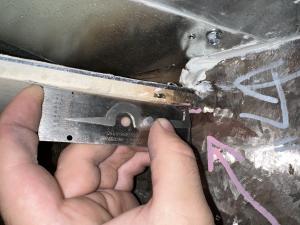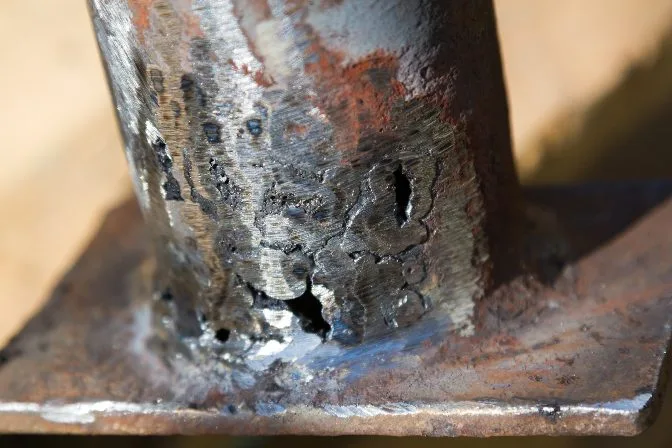Ingenious Techniques to Fillet Weld Examination and Screening: Enhancing Weld Top Quality and Conformity Requirements
In the world of welding, the top quality and honesty of fillet welds play an essential duty in making certain the architectural sturdiness and integrity of different industrial elements. With the constant drive for improved performance and conformity with rigid requirements, the exploration of innovative approaches to fillet weld inspection and screening has actually ended up being vital. As markets evolve, the traditional approaches might no more suffice in fulfilling the needs of modern welding applications. By embracing sophisticated innovations and approaches, a brand-new perspective of possibilities arises in the realm of weld quality analysis and adherence to compliance standards.
Advanced Non-Destructive Testing Approaches
Using modern technologies, progressed non-destructive testing techniques play a critical function in making certain the integrity and high quality of fillet welds. These approaches, such as phased range ultrasonic screening (PAUT) and magnetic particle testing (MPT), deal thorough insights right into the weld's inner structure without triggering any type of damages to the material. PAUT, for instance, uses numerous ultrasonic components to examine the weld from various angles, providing an extensive visualization of prospective issues like absence of blend or fractures.
By using these sophisticated non-destructive testing techniques, weld inspectors can properly examine the high quality of fillet welds, guaranteeing compliance with sector criteria and guidelines. The capability to spot flaws early on not just improves weld quality yet additionally avoids costly rework or failings in structural integrity, underscoring the relevance of these innovative screening techniques in welding evaluations.
Robotics and Automation in Inspection
The assimilation of robotics and automation has changed the assessment process for fillet welds, boosting efficiency and precision in high quality analysis. Robotics use precise control and repeatability in checking welds, guaranteeing regular and trustworthy results. Automated systems can be set to follow certain inspection courses, ensuring complete coverage of welds and minimizing the threat of human error.
Robot examination systems geared up with innovative sensors can discover and gauge weld features with high accuracy, giving detailed data for evaluation. These systems can identify problems such as fractures, absence of fusion, and porosity, allowing timely rehabilitative actions to be taken. Furthermore, robotics and automation enable real-time information collection and evaluation, providing instant comments to drivers and facilitating quick decision-making processes.
Moreover, the usage of robotics and automation in fillet weld examination improves overall efficiency by minimizing examination times and raising inspection throughput. By streamlining the evaluation process, makers can guarantee weld high quality and conformity requirements are fulfilled successfully, inevitably bring about set you back financial savings and boosted product quality.
Using Expert System for Analysis
Expert system plays a critical duty in improving the efficiency and precision of analysis in fillet weld assessment processes. By taking advantage of the power of AI, assessors can simplify the evaluation of weld quality and compliance standards, leading to much more dependable and accurate outcomes. AI formulas can rapidly refine huge quantities of information from weld evaluations, identifying issues or inconsistencies that may be testing to understand the nude eye. This innovative modern technology enables real-time surveillance of weld high quality, enabling prompt rehabilitative activities to be taken if any type of problems are discovered.
Furthermore, AI systems can learn from previous evaluation data, continually enhancing their capability to identify potential defects and deviations in fillet welds. This flexible knowing capacity enhances the overall high quality control process, reducing the probability of human mistake and guaranteeing that welds satisfy the called for standards. By incorporating synthetic knowledge into fillet weld evaluation, markets can accomplish greater degrees of effectiveness, consistency, and compliance in their assessment techniques.
Portable Equipment for On-Site Assessment
 Enhancing area examination effectiveness, the fostering of portable devices revolutionizes on-site evaluation procedures for fillet welds. These tools use versatility and convenience, allowing assessors to carry out comprehensive assessments in numerous areas, including tough or remote settings. Portable tools such as ultrasonic screening devices, magnetic fragment evaluation equipment, and digital radiography systems give real-time data and high-resolution imaging capabilities, allowing quick decision-making and immediate comments on weld top quality.
Enhancing area examination effectiveness, the fostering of portable devices revolutionizes on-site evaluation procedures for fillet welds. These tools use versatility and convenience, allowing assessors to carry out comprehensive assessments in numerous areas, including tough or remote settings. Portable tools such as ultrasonic screening devices, magnetic fragment evaluation equipment, and digital radiography systems give real-time data and high-resolution imaging capabilities, allowing quick decision-making and immediate comments on weld top quality.One substantial benefit of mobile devices is their capacity to improve assessment treatments, lowering downtime and enhancing overall efficiency. Assessors can quickly transfer these devices to different task sites, getting rid of the requirement for delivering heavy equipment or parts to off-site facilities. In addition, the mobility of these tools advertises cost-effectiveness by reducing transportation expenses and speeding up evaluation timelines.
Additionally, making use of portable tools for on-site assessment promotes positive quality assurance measures, as examiners can promptly recognize and attend to any kind of prospective welding problems or disparities. By incorporating these ingenious technologies right into on-site examination techniques, welding professionals can make certain conformity with sector standards and enhance weld quality, ultimately resulting in enhanced structural integrity and safety and security in different welding applications.
Combination of Information Administration Equipment
Having actually optimized on-site assessment processes via the usage of portable tools, the following phase involves the smooth assimilation of data management systems to even more enhance efficiency and information analysis capacities in fillet weld evaluation and screening. Welding Inspection Racine. By integrating information administration systems right into the assessment blog procedure, organizations can improve data collection, storage, and evaluation. This integration enables real-time tracking of weld top quality, immediate recognition of defects, and prompt decision-making to fix any type of problems that might arise during the examination process
Information management systems play an essential function in systematizing examination data, assisting in simple accessibility for licensed employees, and making sure information honesty and safety and security. With the integration of these systems, assessors can click resources create thorough records, track historical information for fad evaluation, and improve overall procedure effectiveness. The combination of information monitoring systems allows seamless interaction in between different stakeholders involved in the inspection process, fostering partnership and boosting total quality control measures. Eventually, the assimilation of data monitoring systems serves to boost the requirements of fillet weld evaluation and screening, making certain compliance with industry regulations and improving weld top quality.
Final Thought
In final thought, ingenious techniques to fillet weld evaluation and testing have substantially improved weld high quality and compliance requirements. Advanced non-destructive testing methods, robotics, automation, synthetic knowledge, portable tools, and information management systems have changed the method weld examinations are performed. By using these modern technologies, industries can ensure that welds satisfy the needed quality standards and policies, inevitably boosting total effectiveness and security in welding processes.

By using these advanced non-destructive screening strategies, weld inspectors can accurately evaluate the top quality of fillet welds, making certain conformity with industry standards and policies. Portable tools such as ultrasonic testing devices, magnetic particle evaluation devices, and electronic radiography systems provide real-time information and high-resolution imaging capabilities, allowing quick decision-making and prompt responses on weld top quality.
Having enhanced navigate to this site on-site inspection processes via the use of portable tools, the next stage includes the smooth assimilation of information administration systems to even more boost efficiency and information evaluation capacities in fillet weld inspection and screening (Welding Inspection Racine). Inevitably, the integration of data administration systems serves to raise the criteria of fillet weld evaluation and testing, making certain compliance with market policies and improving weld high quality
 In verdict, ingenious approaches to fillet weld evaluation and testing have actually dramatically enhanced weld top quality and compliance standards.
In verdict, ingenious approaches to fillet weld evaluation and testing have actually dramatically enhanced weld top quality and compliance standards.